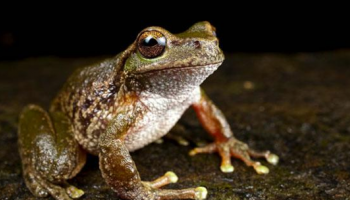A smug, self-righteous vegan eating a panda bear steak. It’s something we’d all like to see, and if anybody feels like hanging around until 2050 they might just get lucky. For the time being, though, the vegans and vegetarians are safely perched on the moral high ground (though that still won’t save them from the global warming livestock contributes to) because of the myriad of problems with meat. Currently, the meat and dairy industries collectively dominate a significant proportion of the Earth’s land area, with 26% of all land used for grazing alone. At the same time as people in Western countries selfishly and systematically ignore the environmental and animal welfare impacts of their high-meat diets, the UN expects world demand for meat to increase by 70% before 2050 as more and more people around the world can afford high meat diets. The consequences for the natural ecosystems that remain are both dire and easy to predict. It will probably take a miracle to avoid the earth being trashed for bacon and sausage rolls. There’s no hope for us — Hang on. Do I hear science coming to the rescue?
Funded by an anonymous millionaire donor, researcher Mark Post of the University of Maastricht (among others) has been developing lab-grown meat. The first proof of concept should be ready later this year, and it will be a hamburger. To make lab-grown beef, for example, stem cells are taken from a cow, which can be done while the cow is alive (although sadly, it is more efficient to slaughter the cow), and then induced to grow into muscle cells in a laboratory. Currently the growth medium used is derived from animal blood, but other researchers are developing plant- or algae-based growth media. Processed meat like sausages or burgers is much easier to manufacture since muscle and fat can be grown separately in tiny slivers a few centimeters long and millimeters thick, then mashed together at the end. A steak, on the other hand, requires many different tissue types working together to create a complex end product.
The first test tube hamburger will cost roughly £200,000, which for consumers represents less value than a traditional hamburger patty which can retail for as little as £2. Dr Post, as well as the New Harvest Foundation (a non-profit organisation set up to promote meat alternatives), believes that ten to fifteen years is an achievable timeframe to develop industrial scale production that will cost as little as field grown meat. Some animal rights groups are enthusiastic about the idea, since one slaughtered cow could potentially provide the stem cells required to make 100 million burgers. People for the Ethical Treatment of Animals (PETA) have offered a £630,000 reward for the first company to manufacture and sell artificial chicken on an industrial scale, for the same price as field meat and with an identical taste. They are placing their focus on a chicken alternative only because it is the meat produced in the largest quantities.
…And then what?
It would perhaps be practical and easy to genetically modify muscle cells to grow better in the lab, or have particular nutrient content. Such a process could engineer new kinds of ‘food’ that aren’t exactly like anything found in nature. In practice, though, GM Test tube meat would probably be dubbed “Frankenfood” by a hysterical media, and it would perhaps be a bit too optimistic to expect everyday consumers (or, for that matter, anybody at all) to trust such a product.
On another note, there is no need to restrict ourselves to chickens and cows. After all, we didn’t find those animals by scouring the planet for the most delicious beings, or at least not to my knowledge. Who knows which are the tastiest? Since the meat is grown from stem cells which can be taken from adult animals in a reasonably non-invasive way, and the technology to grow different species’ muscle would probably be fairly similar across the board, we’d be fools not to try to eat everything. Bring on macaw, gorilla, dolphin, panda. Turn your beloved family pet into a meal the whole family can enjoy – without hurting your pet (finally…). Human burgers may not be too far away – in principle it is the same as growing an animal burger. It would be possible to use your own stem cells to grow your own flesh to eat. Surely that has got to be sustainability at its finest. In any case, it’s possible to imagine a future where young people will ask each other, ‘eugh, you eat field meat? Like grown on a living animal? Umm, like, why would you do that?’ I don’t know about everybody else, but I suspect that by 2030 I’ll have eaten my last lentil and will be loving it.
Disclaimer: The fact that eating meat might be ethical at some point in the future is not intended to provide some sort of defence for meat-eating today. That would be tantamount to a baby murderer claiming that since scientists will invent toy dolls in fifteen years, it’s okay to continue to murder babies in the mean time. Eating meat is a misteak.


